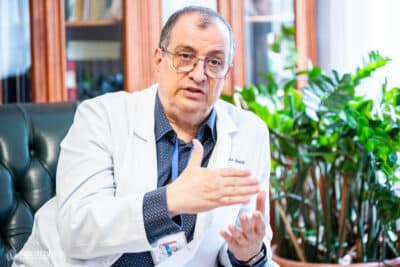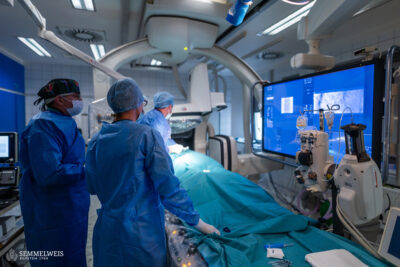 As with other types of cancer, early diagnosis can be lifesaving for head and neck tumors. If the lesion is detected in time, the survival rate for these conditions is 80–90 percent. However, in many cases, the tumor is already at an advanced stage by the time the diagnosis is made, which is why 60 percent of those affected die within five years, says Dr. László Tamás. The professor emphasizes that patients themselves can do the most to ensure the timely detection of head and neck tumors: Anyone experiencing symptoms that persist for more than three weeks – such as hoarseness, difficulty swallowing, pain, or swelling in the neck – should consult an ENT specialist immediately.
As with other types of cancer, early diagnosis can be lifesaving for head and neck tumors. If the lesion is detected in time, the survival rate for these conditions is 80–90 percent. However, in many cases, the tumor is already at an advanced stage by the time the diagnosis is made, which is why 60 percent of those affected die within five years, says Dr. László Tamás. The professor emphasizes that patients themselves can do the most to ensure the timely detection of head and neck tumors: Anyone experiencing symptoms that persist for more than three weeks – such as hoarseness, difficulty swallowing, pain, or swelling in the neck – should consult an ENT specialist immediately.
People who smoke or drink alcohol regularly are strongly advised to have an annual ear, nose, and throat examination even if they have no symptoms, as well as to regularly check and palpate their head and neck area, as neck metastases are often the first symptom of such tumors.
Cancerous lesions affecting the head and neck are considered a common oncological disease worldwide. Unfortunately, Hungary is at the forefront of this, with approximately 5,000 new cases diagnosed each year and 1,600–2,000 deaths attributed to these types of cancer annually.
The most important risk factors are smoking, alcohol consumption, and human papillomavirus (HPV) infection. The latter is responsible not only for the increasing prevalence among younger age groups, but primarily for the rapid increase in the number of oropharyngeal cancers, in particular tonsil tumors.
“It is essential that parents take advantage of the HPV vaccination for both girls and boys, as it can prevent cervical, throat, and tonsil cancer,” the professor emphasizes.
According to Dr. Tamás László, tumors most commonly occur in four areas of the head and neck: the oral cavity, the oropharynx (the tonsils), the hypopharynx, and the larynx. In addition, the department also treats patients with salivary gland, parotid gland, and thyroid cancer, as well as skin cancer, and performs surgery on certain types of tumors in the skull base and eye socket using a special technique involving an endoscope inserted through the nasal cavity.
The professor emphasizes that surgery on cancerous lesions that develop on the head and neck region requires extensive knowledge and skills, because this area of the body is physically very narrow yet extremely important: It is through this part of the body that the brain receives its blood supply, and it is here that all of our cranial nerves pass through, which provide sensory, motor, and autonomic innervation to the neck and face. The tumor must therefore be completely removed in such a way that these functions are retained: swallowing, speech, and taste are not impaired, and the movement of the patient’s facial muscles is preserved.
We often perform large, complex surgeries that must be planned very precisely. Restoring the floor of the mouth, palate, and tongue often requires skin and muscle grafts, and sometimes, this can only be achieved through an 8-10-hour operation that requires the coordinated work of several teams of doctors.
Tumor surgery is a specialty area at Semmelweis University’s Department of Otorhinolaryngology, Head and Neck Surgery. It is the only institution in the country where patients receive complex care, including chemotherapy and immunotherapy, except for radiation therapy. There are a few other institutions like it in Central Europe. The department is unique in that it is the regional training center for head and neck surgeons, accredited by the International Federation of Head and Neck Oncologic Societies (IFHNOS). The license exam taken here is recognized worldwide, adds the director.
Éva Haiman
Translation: Judit Szabados-Dőtsch
Photo by Bálint Barta – Semmelweis University; illustration: Freepik



